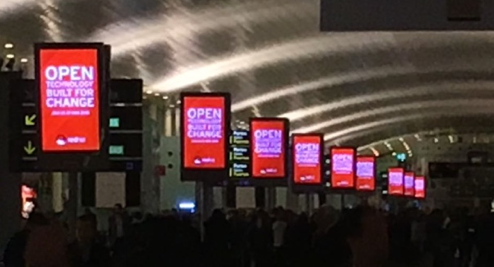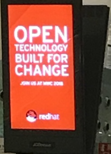It was quite the hectic but extremely successful week here at Mobile World Congress 2018 – the world’s largest mobile industry gathering with more than 100,000 attendees, which added to the hubbub of cultural, sporting, entertainment, industry and gastronomical diversity that is Barcelona.
So, what’s all the buzz about this year? Not surprisingly, the hot topics on everyone’s tongues were 5G, edge clouds (aka mobile edge computing or MEC), artificial intelligence (AI), IoT, video, and blockchain. There were many other technologies pushing the boundaries of our minds like drones, facial recognition, and even virtual reality that enables robots to perform critical medical procedures (even surgery!) on patients many miles from their physicians.
Mobile World Congress did not disappoint. We saw Samsung, LG, Nokia and many more unveiling their latest handsets, smart watches, wearables, pop-up cameras, and tablets. We all know the mobile device-driven world catalyzes our digital economy, and with that in mind, all of the operators were highlighting their accelerated progress towards 5G.
So, amongst all of this frenzy of mobile devices and 5G, what was new from Red Hat at the conference? How does Red Hat support 5G? Red Hat has already showcased the open telco framework it developed to support 5G, and we used Mobile World Congress to demonstrate it for our customers and partners again this week. As communications service providers (CSPs) work diligently to improve their capabilities as digital service providers, the Red Hat open telco framework helps them build an agile, digital services platform and make that transition a reality.
The open telco framework combines three agile open platforms – virtualized network infrastructure, data management, and application development. Red Hat has developed these three open platforms to support the transformation that operators are undergoing to build out their 5G networks. The three open platforms interoperate horizontally with common management, automation, toolsets, storage and real-time telemetry from the centralized data center, to the operators’ points of presence, to the enterprise edge sites (vCPE) and the virtualized radio (vRAN) sites.
What specific announcements and news for Red Hat did we see at Mobile World Congress? First and foremost, we were invited onto the stage this year with a keynote by our CEO, Jim Whitehurst, who talked about how the digital economy can continue to flourish with the right foundations in place to accelerate innovations from networks to security features, compelling services and content, to agile companies and culture.
Hundreds of attendees at our booth and online joined a lively panel discussion, Red Hat Live @ MWC: The Future of Telco is Open, on 5G, MEC, AI, blockchain, IoT, and the future of CSPs. The panel featured Dr. Ray Mota, CEO and principal analyst at ACG Research and Azhar Sayeed, chief architect at Red Hat, and me.
Amid the hundreds of customer, press and analyst briefings at the show, Red Hat also showcased many Red Hat-powered operator and partner solutions including: Virtual central office (VCO) for vCPE, Elisa Self-Organizing Networks (SON) for network automation, Vasona Networks virtual MEC, and MYCOM OSI Telco Cloud Assurance.
So, when will we get to 5G? Most operators are accelerating their 5G trials now, and we expect to see faster rollouts in major urban centers around the world, with expansion driven by the need for quicker return on investments (ROI) for their enterprise customers. As we believe agility is really the only sustainable advantage in any industry, the Red Hat open telco framework is designed to help operators take advantage of their 5G networks to deliver innovative applications and services to people when and where they matter.
Whew! Another Mobile World Congress has wrapped up. Exciting times are ahead. See you all again next year!
Sobre o autor
Ian is Chief Technologist, Global Service Provider Business at Red Hat, the world’s leading provider of open source technologies. Ian brings more than 30 years of engineering, business, and telecommunications industry leadership to Red Hat. Acting as a catalyst and trusted advisor, Ian brings together a wealth of industry and open source community insight to help our customers flourish in the digital economy.
More recently, Ian was responsible for global service provider architecture at Cisco, leading their SDN/NFV portfolio vision and business transformation strategy. With his extensive background in system engineering, product management, and business development, Ian has proven expertise in helping organizations navigate and succeed in today’s fast-paced competitive environment.
Navegue por canal
Automação
Últimas novidades em automação de TI para empresas de tecnologia, equipes e ambientes
Inteligência artificial
Descubra as atualizações nas plataformas que proporcionam aos clientes executar suas cargas de trabalho de IA em qualquer ambiente
Nuvem híbrida aberta
Veja como construímos um futuro mais flexível com a nuvem híbrida
Segurança
Veja as últimas novidades sobre como reduzimos riscos em ambientes e tecnologias
Edge computing
Saiba quais são as atualizações nas plataformas que simplificam as operações na borda
Infraestrutura
Saiba o que há de mais recente na plataforma Linux empresarial líder mundial
Aplicações
Conheça nossas soluções desenvolvidas para ajudar você a superar os desafios mais complexos de aplicações
Programas originais
Veja as histórias divertidas de criadores e líderes em tecnologia empresarial
Produtos
- Red Hat Enterprise Linux
- Red Hat OpenShift
- Red Hat Ansible Automation Platform
- Red Hat Cloud Services
- Veja todos os produtos
Ferramentas
- Treinamento e certificação
- Minha conta
- Suporte ao cliente
- Recursos para desenvolvedores
- Encontre um parceiro
- Red Hat Ecosystem Catalog
- Calculadora de valor Red Hat
- Documentação
Experimente, compre, venda
Comunicação
- Contate o setor de vendas
- Fale com o Atendimento ao Cliente
- Contate o setor de treinamento
- Redes sociais
Sobre a Red Hat
A Red Hat é a líder mundial em soluções empresariais open source como Linux, nuvem, containers e Kubernetes. Fornecemos soluções robustas que facilitam o trabalho em diversas plataformas e ambientes, do datacenter principal até a borda da rede.
Selecione um idioma
Red Hat legal and privacy links
- Sobre a Red Hat
- Oportunidades de emprego
- Eventos
- Escritórios
- Fale com a Red Hat
- Blog da Red Hat
- Diversidade, equidade e inclusão
- Cool Stuff Store
- Red Hat Summit



